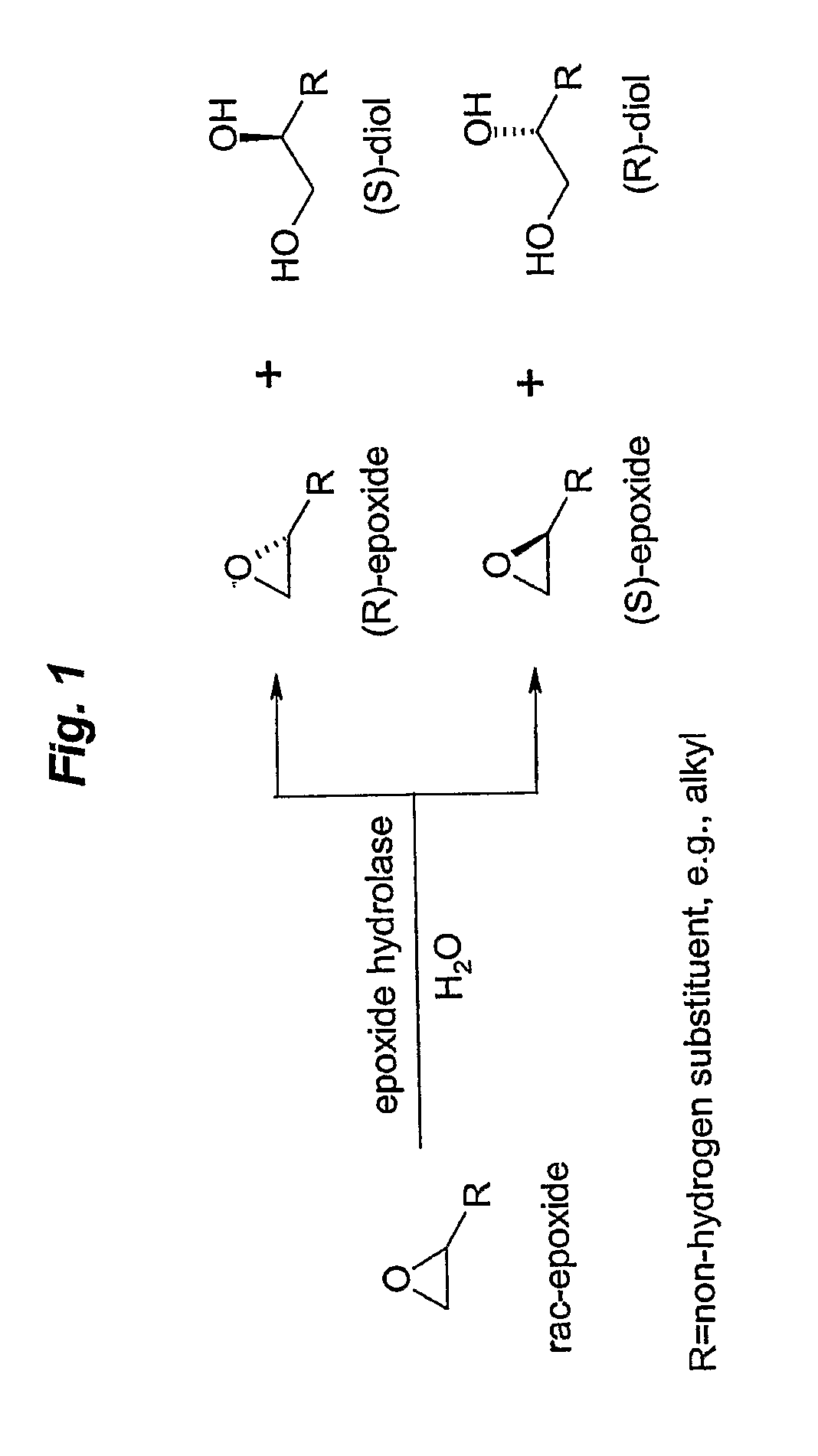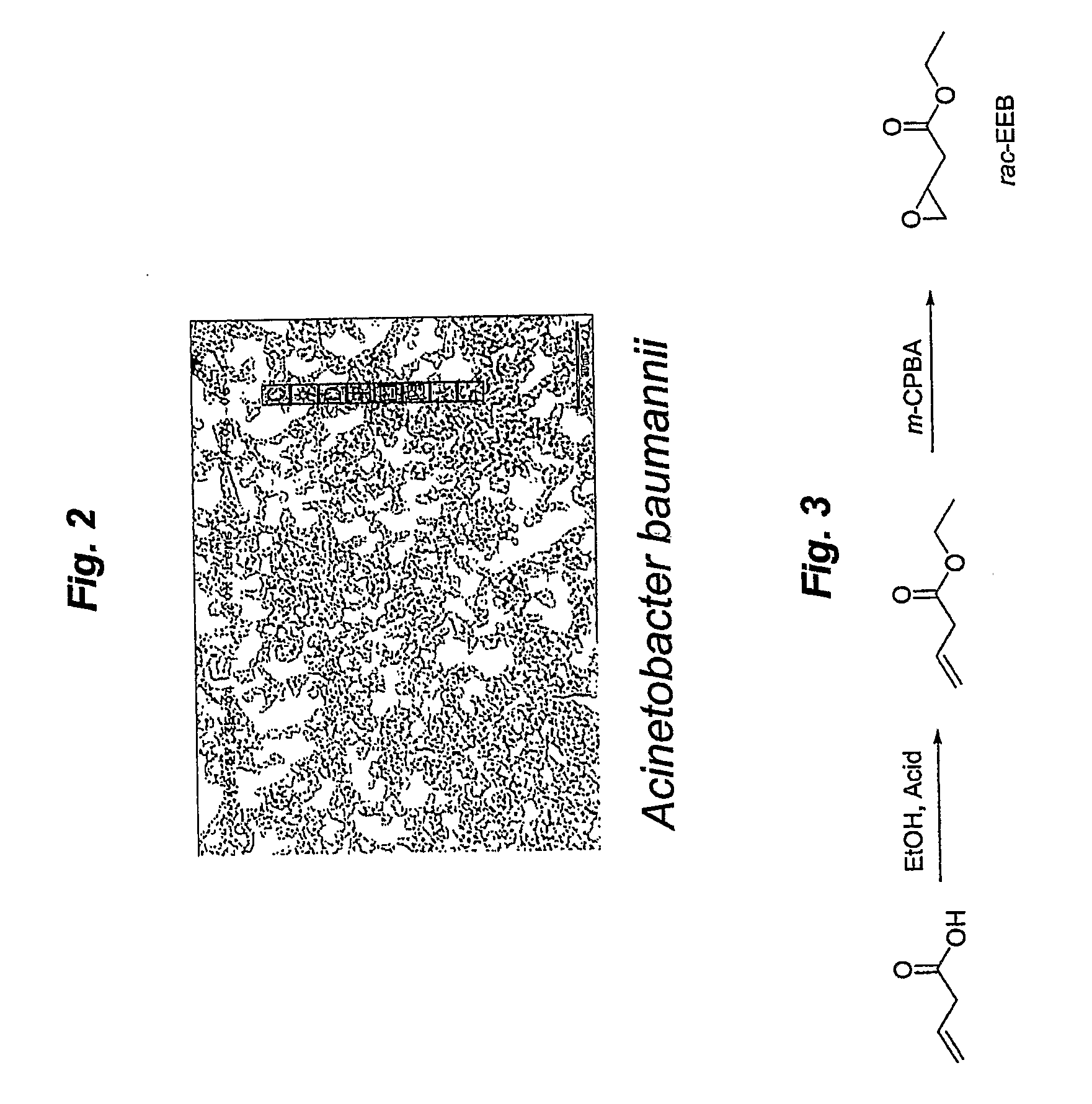Microbial kinetic resolution of ethyl-3,4-epoxybutyrate
a technology of ethyl-3,4-epoxybutyrate and kinetic resolution, which is applied in the field of kinetic resolution of ethyl-3,4-epoxybutyrate, can solve the problems of regio-selectivities, inability to commercialize, and inability to meet the requirements of many commercial applications
- Summary
- Abstract
- Description
- Claims
- Application Information
AI Technical Summary
Benefits of technology
Problems solved by technology
Method used
Image
Examples
example 1
[0075]The following example describes the general research strategy for discovering of EH activity from microorganisms.
[0076]Acinetobacter baumannii ATCC PTA-8303 or Cryptococcus albidus ATCC PTA-8302 were discovered in a research strategy which involved: 1) isolation of microorganisms from the natural environment (e.g. soil samples) which may contain EH activity; 2) high throughput (HTS) screening to identify microorganisms with EH activity and enantioselective screening of microorganisms with EH activity; 3) identification and characterization of newly isolated, pure, microorganisms with EH activity; and 4) optimization of EH activity in the newly isolated, pure, microorganisms for kinetic resolution purposes (see, FIG. 4).
[0077]1. Isolation of Microorganisms from Environmental Sources
[0078]The soil samples are collected from versatile natural environments, followed by inoculation into the culture medium containing basal nutrients. After preliminary cultivation, cells are cultivat...
example 2
[0085]The specific microorganisms, Acinetobacter baumannii ATCC PTA-8303 and Cryptococcus albidus ATCC PTA-8302, comprising EH activity, were discovered utilizing the specific research strategy discussed below. Its use in the preparation of enantioenriched EEB is also described in the following example.
[0086]1. Isolation of Microorganisms from Environmental Sources
[0087]The microorganisms originated from soil samples were grown at 30° C. in nutrient broth (pH 7.0), consisting of bacto peptone 10 g / l, yeast extract 5 g / l, and NaCl 10 g / l. After several subcultivations in the medium containing 2% (v / v) aliphatic alkene, such as hexene, heptene, octene or hexadecene, as sole carbon sources, repeated streaking on agar plates containing the same medium was carried out. The medium composition was shown in Table 2.
TABLE 2The medium composition for screening of alkene-utilizing strains.compoundsconcentrationAlkenes (octene or hexadecene)2%(v / v)Yeast extract0.1g / lMgCl2•6H2O0.075g / lK2HPO41.55...
example 3
[0096]The following example illustrates the kinetic resolution of various racemic alkyl 3,4-epoxybutyrates by Acinetobacter baumannii and Cryptococcus albidus via enantioselective epoxide opening.
[0097]Synthesis of Racemic alkyl-3,4-epoxybutyrates:
[0098]The substrate for kinetic resolution, i.e., alkyl 3,4-epoxybutyrates, were synthesized via acid-catalyzed esterification of 3-butenoic acid, followed by epoxidation with 3-chloroperoxybenzoic acid (m-CPBA) (See, FIG. 6A). Alkyl (R)-3,4-epoxybutyrates were also synthesized via esterification of (R) 4-chloro-3-hydroxybutyric acid with corresponding alcohols, followed by base-catalyzed ring formation and was used as a standard for chiral GC analysis. (See, FIG. 6B)
[0099]Kinetic Resolution of alkyl-3,4-epoxybutyrates:
[0100]Acinetobacter baumannii and Cryptococcus albidus were cultured at 30° C. on the same medium used in Example 2 paragraph 4a. The cells were harvested by centrifugation and washed twice with distilled water. The wet cell...
PUM
| Property | Measurement | Unit |
|---|---|---|
| Fraction | aaaaa | aaaaa |
| Angle | aaaaa | aaaaa |
| Density | aaaaa | aaaaa |
Abstract
Description
Claims
Application Information
 Login to View More
Login to View More - R&D
- Intellectual Property
- Life Sciences
- Materials
- Tech Scout
- Unparalleled Data Quality
- Higher Quality Content
- 60% Fewer Hallucinations
Browse by: Latest US Patents, China's latest patents, Technical Efficacy Thesaurus, Application Domain, Technology Topic, Popular Technical Reports.
© 2025 PatSnap. All rights reserved.Legal|Privacy policy|Modern Slavery Act Transparency Statement|Sitemap|About US| Contact US: help@patsnap.com



